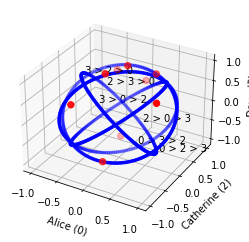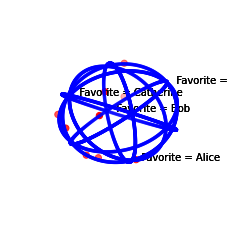Profile#
[1]:
import svvamp
Define a random generator of profiles using the Spheroid model (which extends Impartial Culture to utilities), with 9 voters and 5 candidates:
[2]:
random_profile = svvamp.GeneratorProfileSpheroid(n_v=9, n_c=5)
random_profile
[2]:
<svvamp.preferences.generator_profile_spheroid.GeneratorProfileSpheroid at 0x21b46c98770>
Use the generator to create a random profile:
[3]:
profile = random_profile()
If you wish, you can give a label to each candidate:
[4]:
profile.labels_candidates = ['Alice', 'Bob', 'Catherine', 'Dave', 'Ellen']
Basic information about the profile:
[5]:
profile.n_v
[5]:
9
[6]:
profile.n_c
[6]:
5
[7]:
profile.labels_candidates
[7]:
['Alice', 'Bob', 'Catherine', 'Dave', 'Ellen']
Voters’ rankings of preference:
[8]:
profile.preferences_rk
[8]:
array([[2, 3, 1, 0, 4],
[4, 2, 0, 3, 1],
[4, 2, 0, 3, 1],
[1, 2, 0, 4, 3],
[4, 3, 0, 2, 1],
[3, 1, 2, 4, 0],
[1, 2, 3, 4, 0],
[3, 2, 1, 4, 0],
[4, 2, 0, 1, 3]])
Voters’ utilities for the candidates:
[9]:
profile.preferences_ut
[9]:
array([[-0.44458068, 0.14553558, 0.68052773, 0.16357809, -0.5397144 ],
[ 0.0268188 , -0.67982384, 0.25992916, -0.19772748, 0.65609525],
[-0.40017529, -0.78147922, -0.2535415 , -0.40465215, 0.03351569],
[ 0.14343979, 0.50952062, 0.36903622, -0.76264855, 0.04464546],
[-0.23395736, -0.71376382, -0.63007483, -0.19696857, 0.0037754 ],
[-0.23303553, 0.46519408, 0.45194157, 0.70715693, 0.15800885],
[-0.77027357, 0.45199658, 0.40743494, 0.17577499, 0.0740111 ],
[-0.65635213, 0.20304854, 0.45371884, 0.54194463, 0.1685479 ],
[ 0.0364911 , -0.59018254, 0.19841761, -0.74973679, 0.22108407]])
Plot the restriction of the population to 3 candidates, for example [0, 2, 3] (Alice, Catherine and Dave), in the utility space:
[10]:
profile.plot3(indexes=[0, 2, 3])

Plot the restriction of the population to 4 candidates, for example [0, 1, 2, 4] (Alice, Bob, Catherine and Ellen), in the utility space:
[11]:
profile.plot4(indexes=[0, 1, 2, 4])

Plurality score, Borda score and total utility of each candidate:
[12]:
profile.plurality_scores_ut
[12]:
array([0, 2, 1, 2, 4])
[13]:
profile.borda_score_c_ut
[13]:
array([11., 16., 25., 18., 20.])
[14]:
profile.total_utility_c
[14]:
array([-2.53162488, -0.98995401, 1.93738974, -0.72327889, 0.8199693 ])
Matrix of duels (weighted majority graph) and matrix of victories (unweighted majority graph):
[15]:
profile.matrix_duels_ut
[15]:
array([[0, 4, 1, 4, 2],
[5, 0, 3, 3, 5],
[8, 6, 0, 6, 5],
[5, 6, 3, 0, 4],
[7, 4, 4, 5, 0]])
[16]:
profile.matrix_victories_ut_abs
[16]:
array([[0., 0., 0., 0., 0.],
[1., 0., 0., 0., 1.],
[1., 1., 0., 1., 1.],
[1., 1., 0., 0., 0.],
[1., 0., 0., 1., 0.]])
Condorcet winner:
[17]:
profile.condorcet_winner_ut_abs
[17]:
2
By convention, if there is no Condorcet winner, then SVVAMP returns nan (not a number).